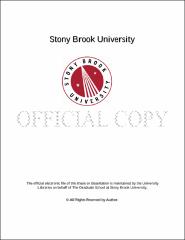| dc.identifier.uri | http://hdl.handle.net/11401/76976 | |
| dc.description.sponsorship | This work is sponsored by the Stony Brook University Graduate School in compliance with the requirements for completion of degree. | en_US |
| dc.format | Monograph | |
| dc.format.medium | Electronic Resource | en_US |
| dc.language.iso | en_US | |
| dc.publisher | The Graduate School, Stony Brook University: Stony Brook, NY. | |
| dc.type | Dissertation | |
| dcterms.abstract | Healing critical sized bone defects has been a challenge that led to innovations in tissue engineering scaffolds and biomechanical stimulations that enhance tissue regeneration. Carbon nanocomposite scaffolds have gained interest due to their enhanced mechanical properties. However, these scaffolds are only osteoconductive and not osteoinductive. Stimulating regeneration of bone tissue, osteoinductivity, has therefore been a subject of intense research. We propose the use of carbon nanoparticle enhanced photoacoustic (PA) stimulation to promote and enhance tissue regeneration in bone tissue-engineering scaffolds. In this study we test the feasibility of using carbon nanoparticles and PA for in vivo tissue engineering applications. To this end, we investigate 1) the effect of carbon nanoparticles, such as graphene oxide nanoplatelets (GONP), graphene oxide nano ribbons (GONR) and graphene nano onions (GNO), in vitro on mesenchymal stem cells (MSC), which are crucial for bone regeneration; 2) the use of PA imaging to detect and monitor tissue engineering scaffolds in vivo; and 3) we demonstrate the potential of carbon nanoparticle enhanced PA stimulation to promote tissue regeneration and healing in an in vivo rat fracture model. The results from these studies demonstrate that carbon nanoparticles such as GNOP, GONR and GNO do not affect viability or differentiation of MSCs and could potentially be used in vivo for tissue engineering applications. Furthermore, PA imaging can be used to detect and longitudinally monitor subcutaneously implanted carbon nanotubes incorporated polymeric nanocomposites in vivo. Oxygen saturation data from PA imaging could also be used as an indicator for tissue regeneration within the scaffolds. Lastly, we demonstrate that daily stimulation with carbon nanoparticle enhanced PA increases bone fracture healing. Rats stimulated for 10 minutes daily for two weeks showed 3 times higher new cortical bone BV/TV and 1.8 times bone mineral density, compared to non-stimulated controls. The results taken together indicate that carbon nanoparticle enhanced PA stimulation serves as an anabolic stimulus for bone regeneration. The results suggest opportunities towards the development of implant device combination therapies for bone loss due to disease or trauma. | |
| dcterms.available | 2017-09-20T16:51:34Z | |
| dcterms.contributor | Qin, Yi-Xian | en_US |
| dcterms.contributor | Sitharaman, Balaji | en_US |
| dcterms.contributor | Vaska, Paul | en_US |
| dcterms.contributor | Penna, James. | en_US |
| dcterms.creator | Talukdar, Yahfi | |
| dcterms.dateAccepted | 2017-09-20T16:51:34Z | |
| dcterms.dateSubmitted | 2017-09-20T16:51:34Z | |
| dcterms.description | Department of Biomedical Engineering | en_US |
| dcterms.extent | 153 pg. | en_US |
| dcterms.format | Application/PDF | en_US |
| dcterms.format | Monograph | |
| dcterms.identifier | http://hdl.handle.net/11401/76976 | |
| dcterms.issued | 2017-05-01 | |
| dcterms.language | en_US | |
| dcterms.provenance | Made available in DSpace on 2017-09-20T16:51:34Z (GMT). No. of bitstreams: 1
Talukdar_grad.sunysb_0771E_13282.pdf: 4088903 bytes, checksum: db48e3f8aa20c46547cd0e22efe2818d (MD5)
Previous issue date: 1 | en |
| dcterms.publisher | The Graduate School, Stony Brook University: Stony Brook, NY. | |
| dcterms.subject | Bone, Carbon nanoparticles, Graphene, Mesenchymal stem cells, Photoacoustic Imaging, Tissue Engineering | |
| dcterms.subject | Biomedical engineering -- Nanotechnology | |
| dcterms.title | Carbon Nanoparticle Enhance Photoacoustic Imaging and Therapy for Bone Tissue Engineering | |
| dcterms.type | Dissertation | |

